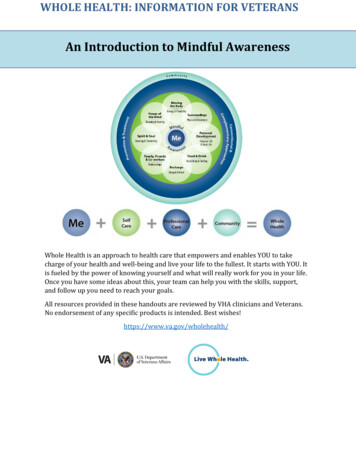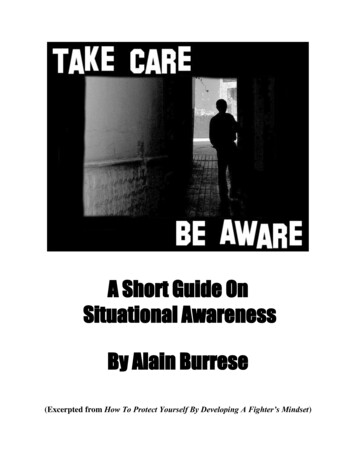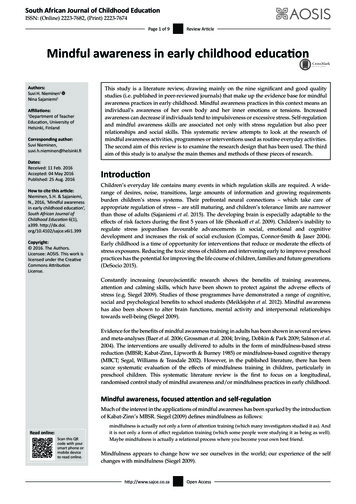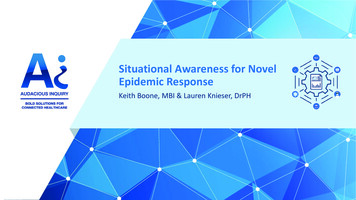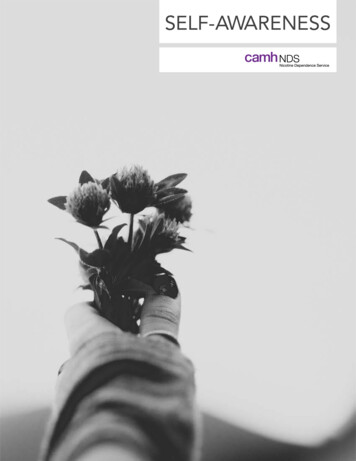
Transcription
SELF-AWARENESS
TABLE OF CONTENTSIntroduction 3Is this workbook right for you? (AUDIT questionnaire) 4What does your score mean? 5Internal and External Supports 6Immediate crisis support 6Your personal support system 7Self-Awareness 8Your current drinking patterns 8How do your numbers compare to the low-risk drinking guidelines? 9Setting goals 10Life goals and alcohol use 11Cutting down or stopping drinking? 12Your change plan contract 13Keeping track of your drinking 14Daily tracking log 15Triggers 19Strategies for Success 20Handling tough situations 21Saying “no” 21Reward yourself 22New activities 23Financial benefits of reducing or quitting drinking 24Dealing with Setbacks and Slips 25Back on track plan 26Health Effects 27Effects of high-risk drinking 27Alcohol use among smokers and cancer risk 28Conclusion 29References 30
INTRODUCTIONWelcome to the Self-Awareness Workbook! This workbook was developed by the Centre for Addiction and MentalHealth’s Nicotine Dependence Service. In this workbook, we offer guidance, tips, tools, and resources to help reduce or quitdrinking.Why is this workbook important?Alcohol is often enjoyed when socializing with friends or family. Different people drink alcohol at different levels. Everyone’sbody responds differently to the alcohol they consume. Regardless of how much you drink, it is important to know thehealth effects linked to drinking alcohol, including cancers, liver damage, and high blood pressure. The harms of drinkingare especially high among people who smoke. Compared to people who do not drink or smoke, those who drink and smokeheavily have a 300 times increased risk of cancer. Drinking alcohol makes it easier for cancer-causing chemicals in tobaccosmoke to be absorbed in the tissues of the mouth and can greatly increase the risk of developing cancers of the head, neck anddigestive system. This workbook is designed to help you understand your risks and address them in the best way for you.This workbook is not for everyone!As a first step, we recommend completing the questionnaire on page 4 and referring to page 5 to figure out if this workbookis right for you.If you have been found to drink at levels that indicate a high risk of alcohol dependence, this workbook is not appropriate foryou. We recommend you stop drinking alcohol and seek guidance from a health professional (see page 6).If you have been found to drink at risky levels but not alcohol dependent, this workbook is for you! This workbook isdesigned to help you create a healthy relationship with alcohol and reduce your risk of cancer associated with drinking alcoholand smoking. You can directly decrease your risk by reducing or quitting drinking. By following the steps listed throughoutthis workbook, we can help you set goals and make positive changes in your health and lifestyle.There is no right or wrong way to use this workbook. Feel free to take your time with the activities and repeat them as oftenas you would like. We hope this workbook can help you become self-aware of your drinking behaviour and improve yourquality of life.Thank you for bringing us along on this journey. You can make the change, and we are here to help!3
AUDIT questionnaireThis questionnaire is to help you figure out if this workbook is appropriate for you or not. For each question in the chart below,CIRCLE the box that best describes your answer. Write the score for each circled box at the end of each line, then total thesenumbers at the bottom of the page.NOTE: In Canada, a single drink serving contains 13.6 grams of ethanol or “pure” alcohol. Although the drinks below aredifferent sizes, each one contains the same amount of pure alcohol and counts as a single drink:341 mL (12 oz.)of beer(about 5% alcohol)341 mL (12 oz.)of cider/cooler(about 5% alcohol)Questions142 mL (5 oz.)of wine(about 12% alcohol)43 mL (1.5 oz.)of hard liquor(about 40% alcohol)0 points1 point2 points3 points4 points1 How often do you have a drink containingalcohol?NeverMonthly orless2 to 4 times amonth4 or moretimes a week2 How many drinks containing alcohol doyou have on a typical day when you aredrinking?3 How often do you have 5 or more drinks onone occasion?4 How often during the last year have youfound that you were not able to stopdrinking once you had started?5 How often during the last year have youfailed to do what was normally expected ofyou because of drinking?6 How often during the last year have youneeded a first drink in the morning toget yourself going after a heavy drinkingsession?7 How often during the last year have you hada feeling of guilt or remorse after drinking?8 How often during the last year have youbeen unable to remember what happenedthe night before because of your drinking?9 Have you or someone else been injuredbecause of your drinking?10 Has a relative, friend, doctor, or other healthcare worker been concerned about yourdrinking or suggested you cut down?1 or 23 or 45 to 62 to 3times aweek7 to 9NeverLess thanmonthlyLess thanmonthlyMonthlyWeeklyMonthlyWeeklyDaily oralmost dailyDaily oralmost dailyNeverLess thanmonthlyMonthlyWeeklyDaily oralmost dailyNeverLess thanmonthlyMonthlyWeeklyDaily oralmost dailyNeverLess thanmonthlyLess thanmonthlyMonthlyWeeklyMonthlyWeeklyDaily oralmost dailyDaily oralmost dailyNeverNeverNoNoYes, but not inthe last yearYes, but not inthe last year#pts.10 or moreYes, duringthe last yearYes, duringthe last yearTotal points Note: This questionnaire (the AUDIT) is adapted from the National Institute on Alcohol Abuse and Alcoholism, which reprintedthe AUDIT with permission from the World Health Organization. To reflect drink serving sizes in Canada (13.6g of pure alcohol),the number of drinks in question 3 was changed from 6 to 5. A free AUDIT manual with guidelines for use in primary caresettings is available online at www.who.org.4
What does your score mean?Now that you have competed the AUDIT questionnaire (page 4), total up your scores for each answer. The maximum possibletotal is 40 points.Compare your score with the chart below to help determine if this workbook is appropriate for you.Women andMen: 20 pointsYou are drinking at levels that indicate a high risk of alcohol dependence.This workbook may not be appropriate for you. We recommend you stopdrinking alcohol and seek guidance from a health professional (see page 5for support options).Women: 4-19 pointsMen: 5-19 pointsYou are drinking at levels that indicate risky drinking. We recommend youuse this workbook to help you cut down or quit drinking alcohol.Women: 0-3 pointsMen: 0-4 pointsYou are drinking at low-risk levels. We encourage you to continue yourprogress to protect your health. You may choose to use this workbook tomonitor your progress and increase your self-awareness.Why is there a difference between women’s and men’s scores?Research shows that women start to have alcohol-related problems at lower drinking levels than mendo. One reason is that, on average, women tend to weigh less than men. In addition, alcohol dispersesin body water, and pound for pound, women have less water in their bodies than men do. So after aman and woman of the same weight drink the same amount of alcohol, the woman’s blood alcoholconcentration will tend to be higher, putting her at greater risk for harm.Source: NIAAA. Rethinking Drinking: Alcohol & your health.5
INTERNAL AND EXTERNAL SUPPORTSImmediate crisis supportThe following are a few resources to help you find support near you:ConnexOntario provides free and confidential health services information for people experiencing problems with alcohol anddrugs, mental illness or gambling www.connexontario.caDrug and Alcohol Helpline provides information about drug and alcohol addiction services in Ontario The service is liveanswer 24/7, confidential and free.Call 1-800-565-8603Or visit their website: www.drugandalcoholhelpline.caSmokers’ Helpline is a free, confidential service offering support and information about quitting smoking and tobacco use.There are 4 ways to get help from Smokers’ Helpline:1. Call 1 877 513-53332. Join the online quit program for tips, tools and support 24/73. Sign up for customized text messages offering support4. Access free booklets on smoking and quittingFeeling depressed or anxious?It’s common for people to feel depressed or anxious when working through risky health behaviours. Mildsymptoms may go away if you cut down or stop drinking. See your health care provider or a mentalhealth professional if your symptoms don’t go away or get worse. If you’re having suicidal thoughts,call your health care provider or go to the nearest emergency room right away. Effective treatment isavailable to help you through this difficult time.Source: NIAAA. Rethinking Drinking: Alcohol & your health.6
Your personal support systemYou can also seek help from the people in your life and support groups. Try to find trustworthy people in your life to share inyour journey, or find an established support group.Who are some people that can help you in your journey to make a positive change?Name:Phone: Email:Name:Phone: Email:Name:Phone: Email:Name:Phone: Email:Have a plan of how you want your support team to help you. Some options of what to ask for are:“Please don’t offer medrinks.”“Can we have an alcoholfree dinner party?”“Do you have anyencouraging words tokeep me going?”“If you see that I’mstressed, can you stepin and offer help?”What are some other ways you could ask your support network for help?.7
SELF-AWARENESSThis section focuses on some of the steps you can take to better understand your drinking patterns and to set goals for drinkingat healthier levels. You have already completed the AUDIT questionnaire on page 4.Your current drinking patternsThis next exercise helps you understand your current drinking patterns by asking about your alcohol consumption over the past7 days.Reminder: In Canada, a single drink serving contains 13.6 grams of ethanol or “pure” alcohol. Although the drinks below aredifferent sizes, each one contains the same amount of pure alcohol and counts as a single drink:341 mL (12 oz.)of beer(about 5% alcohol)1.2.3.4.341 mL (12 oz.)of cider/cooler(about 5% alcohol)142 mL (5 oz.)of wine(about 12% alcohol)43 mL (1.5 oz.)of hard liquor(about 40% alcohol)Please circle yesterday’s day of the week (e.g., if today is Monday, circle Sunday).Starting on the day you circled (yesterday), please write down the number of drinks you had that day.Continue following the arrows back. In each box, write the number of drinks you had on that day.On days where you did not have anything to drink, please write “0.” Do not leave any of the boxes ursdayAdd up the # of drinks over the past 7 days:8
How do your numbers compare to the low-risk drinking guidelines?What’s “low-risk” drinking?Generally, the less alcohol you drink, the more you reduce your health risks. In Canada, there are a few low-riskdrinking guidelines established to help guide individuals to drink within safe limits. The Canadian Cancer Society (CCS)makes recommendations to reduce the risk of developing cancer as a result of drinking alcohol:Low-risk drinking limits1 2 38 9 104 5 6 774 15 16 111 12 13 11 22 23 2418 19 20 2128 29 30 325 26 27On anysingleDAYPerWEEKMenWomenLess thanLess than2141drinks on any daydrink on any dayLess thanLess than7drinks in any weekdrinks in any weekYou may see other low-risk drinking guidelines that allow for higher drinking levels on a given day or week. There is merit todifferent recommendations, but the Canadian Cancer Society guidelines are set to reduce your risk of developing several typesof cancer, including mouth and throat cancers.The risk of developing mouth and throat cancers is higher for smokers than for non-smokers“Low risk” is not “no risk.” Even within these limits, drinkers can have problems if they drink too quickly, have health problems,or are older. Based on your health and how alcohol affects you, you may need to drink less or not at all. If you are pregnant, youare strongly advised not to drink at all.What’s “risky” drinking?For healthy adults in general, drinking more than the single-day or weekly limits recommended by the Canadian CancerSociety is considered “risky” drinking.About 1 in 4 smokers in Ontario drink at risky levels.It makes a difference both how much you drink on any day and how often you have a “heavy drinking day”—that is, more than5 drinks in a day. The more drinks in a day and the more heavy drinking days over time, the greater the chances for healthproblems.Source: NIAAA. Rethinking Drinking: Alcohol & Your Health; CAMH Internal Data.9
Setting goalsBefore setting specific goals, it is important to first decide whether you want to cut down drinking or quit drinking. Both arelegitimate goals. Your choice could depend on your personal circumstances.It is recommended that you stop drinking if you:It is recommended that you reduce drinking if you: Were not recommended to quit drinking by yourhealth care provider Have been advised by your health care providerto quit drinking Do not feel ready to quit drinking right now Drink at levels that don’t negatively interfere withyour:Have health problems such as liver disease ormental illness Are taking medications such as sedatives,painkillers or sleeping pills Have a personal or family history of drinkingproblems Have a family history of cancer or other riskfactors for cancer Are pregnant, trying to get pregnant orbreastfeeding (there is NO safe level of drinkingin this situation) Will be operating vehicles such as cars, trucks,motorcycles, boats, snowmobiles, all-terrainvehicles or bicycles Are responsible for the safety of others at workor at homeǿǿǿǿǿǿǿǿǿǿǿǿPersonal relationshipsWork responsibilitiesPhysical healthEmotional healthSocial well-beingSpiritual/ethical well-beingRemember: If you scored 20 points or higher on the AUDIT questionnaire (page 4), we recommend you stop drinking alcoholand seek guidance from a health professional (see page 6 for options).Source: BC Partners for Mental Health and Addictions. Problem Substance Use Workbook; Capital Health Addiction Services.My Choice: A workbook for making changes.10
Life goals and alcohol useBefore thinking about your specific drinking goals, think more broadly about your life goals, at least for the next few months.What do you hope to accomplish? Will your current level of drinking help or hurt your goals?What would you want to accomplish overthe next few months?Would drinking at your current level makeit EASIER or HARDER for you to reachthese goals?EasierNo effectHarder1.2.3.4.5.Source: College of Family Physicians of Canada and Canadian Centre on Substance Abuse. Drinking Smart: Your Health andAlcohol Consumption.11
.Cut down drinkingStop drinkingExamples could include: to lose weight, to sleep better, to be a better parent to my kids, to be happierCons: What are some reasons why you might not want to.Cut down drinkingStop drinkingTake a look at your pros and cons Highlight the points that you value the most Take a good look at your answers What stands out as being very important to you? What is not as important as you thought itmight be?Now it’s time to make a decision - which you can always change later! - about what will work best for you: cutting down orstopping drinking?Write your decision here: for my drinking goal, I have chosen to:12
Your change plan contractI want to drink no more than drink(s) on any day and no more than drink(s) per week(see page 9 for low-risk drinking guidelines)My goal:orI want to stop drinkingMy start date:I will start my change plan on this date:My reasons:My most important reasons to make these changes are:My strategies:I will use these strategies to help make these changes (see page 20 for ideas):My support system:The people who can help me are (names and how they can help) (see page 7 for ideas):Signs thatI’m doing well:I will know my plan is working if:My challengesand solutions:Some things that might interfere and how I’ll handle them (see pages 19-21 for ideas):Signature:Optional,As your health care provider, I commit to providing professional support and guidance to help you make these changes:Health Care Provider Signature:Source: NIAAA. Rethinking Drinking: Alcohol & Your Health.13
Keeping track of your drinkingKeeping track of your drinking can give you an idea of how much you drink and in which situations. Tracking your smokingalongside your drinking can help you get an overall picture of your behaviours and how they interact with each other.You may find that keeping a drinking and smoking log helps you stick to your goals and monitor your progress. It may beinconvenient to track every drink, but committing to a tracking log may prove useful over time.You will be asked to track how many “standard” drinks you have each day. As a reminder, a “standard drink” in Canada ismeasured as having 13.6 g of pure alcohol. The picture below may help give an idea of what that looks like in different types ofdrinks:Beer341 mL(12 oz.)5% alcoholCider/Cooler341 mL(12 oz.)5% alcoholWine142 mL(5 oz.)12% alcoholHard Liquor43 mL(1.5 oz.)40% alcohol14
Daily tracking logInstructions:1. At the top of your daily tracking log, write your drinking goal if you have decided on one (see page 13). Leave this spaceblank if you have not.For each day:.Source: Capital Health Nova Scotia. My Choice! Daily Drinking Tracking Log.15
Example: Daily tracking logGOAL: No more than 3 drinks on a day and 15 per week.Feb / 2016month/yearTotal # ofTotal # ofcigarettes for standardthe daydrinks for thedayIf you did not If you did notsmoke on adrink on a day,day write “0” write “0”Urges todrink?Situation of thedrinking or urgeThoughts and feelings aboutyour drinking or urgesRate thestrengthof the urgefrom 0-5Write who youwere with (oralone) where youwere, and whenDuring the times you did drinkor had urges to drink, writethe feeling, thoughts you werehaving at the time. (e.g., youwere bored, stressed, relaxed)Fought really hard to resist a beerafter dinnerMonday 18603Tuesday 19300Wednesday 201235Was watching TVWas bored, nothing good onTVThursday 21904Went to dad’shouseWanted to drink but didn’tbecause dad is trying to quitFriday 221555Went out to barwith friendsWanted to relax after work, andpartySaturday 231775Had a get-togetherat my placeWas nervous that people werenot having fun, and everyone elsewas drinkingSunday 24802Total # of drinks this week: 15Additional notes: I had some pretty strong urges this week. I don’t feel that I dealt with them in the best way since I drank over mydaily goal a bunch on the weekend. But I did have some urges which I dealt with. I didn’t drink on those days and I am happy aboutthat. I noticed I drink more when I’m smoking I’m going to ask the nurse about that.16
Daily tracking logGOAL: No more than/month/yeardrinks on a day andTotal # ofTotal # ofcigarettes for standardthe daydrinks for thedayIf you did not If you did notsmoke on adrink on a day,day write “0” write “0”per week.Urges todrink?Situation of thedrinking or urgeThoughts and feelings aboutyour drinking or urgesRate thestrengthof the urgefrom 0-5Write who youwere with (oralone) where youwere, and whenDuring the times you did drinkor had urges to drink, writethe feeling, thoughts you werehaving at the time. (e.g., youwere bored, stressed, aySundayTotal # of drinks this week:Additional notes:17
Daily tracking logGOAL: No more than/month/yeardrinks on a day andTotal # ofTotal # ofcigarettes for standardthe daydrinks for thedayIf you did not If you did notsmoke on adrink on a day,day write “0” write “0”per week.Urges todrink?Situation of thedrinking or urgeThoughts and feelings aboutyour drinking or urgesRate thestrengthof the urgefrom 0-5Write who youwere with (oralone) where youwere, and whenDuring the times you did drinkor had urges to drink, writethe feeling, thoughts you werehaving at the time. (e.g., youwere bored, stressed, aySundayTotal # of drinks this week:Additional notes:18
TriggersTriggers are the patterns that usually occur before or around the time you drink. Triggers can be people, places, activities, etc.For example, you might learn that you drink more when you are smoking, or when you visit your neighbour on the weekend. Inthese cases, smoking and visiting your neighbour on the weekend are all triggers.It is important to know what your triggers are and to have a plan for dealing with them in a way other than drinking. This willgive you a better chance of achieving your goals.Identifying my TriggersNote: To complete this exercise, you’ll need to have completed the Daily tracking log (page 17) for at least two weeks, preferablylonger. The longer you have completed the Daily tracking log, the more easily you’ll be able to see patterns in your drinkingbehaviour.Take a look at your entries in the Daily tracking log so far. Look at the days that you drank more than your daily goal and thedays you had the strongest urge to drink. Place a mark beside these days or highlight them. Now look at what you have writtenin the last two columns on the days you highlighted (the ones titled “Situation of the drinking or urge” and “Thoughts andfeelings about your drinking or urges”). Copy what you wrote on those days here:Source: Capital Health Addiction Services. My Choice: A workbook for making changes.19
STRATEGIES FOR SUCCESSFollow these tips to help you reduce the amount you drink or to quit drinking alcohol. By following these steps and coming upwith strategies of your own, you can improve your health and reduce your risk of developing certain cancers:Steps to reduce drinkingSteps to quit drinkingPlan ahead and set a limit on the amount you will drink (seepage 13).If you are thirsty, use a non-alcoholic drink like water toquench your thirst.If you are thirsty, use a non-alcoholic drink like water toquench your thirst.Do an activity when you are out with friends to help distractyou, like playing pool or dancing. Drink water during theseactivities.Alternate alcoholic beverages with non-alcoholic drinks likewater, soft drinks or juice.Drink alcoholic beverages slowly.Don’t use alcohol to cope with stress. Go for a walk, take abath, read a book or listen to some of your favourite music tohelp you relax.Space out your alcoholic drinks.Have something to eat or a non-alcoholic drink.Try to drink lower alcohol content drinks, or mix alcoholicdrinks with water, low-calorie soft drinks, club soda or juice.Leave the situation.Use relaxation techniques, such as breathing or meditating.Don’t refill your glass until it is empty.Don’t “free pour” drinks because you may be drinking morethan you think. Measure the amount of alcohol when youpour drinks so you know how much you are drinking.Don’t try to keep up with your friends “drink for drink”because everyone handles alcohol differently.Take the money you would have used to drink and put ittowards something you have always wanted (vacation, newoutfit, night out, etc.)Make a list of why you don’t want to drink and refer to itwhen triggers pop up.Avoid playing drinking games because they can make youdrink large amounts of alcohol in a short time.Eat before and while you are drinking.Snack with your drinks, but avoid salty snacks like potatochips. Salty snacks can make you thirsty and may cause youto drink more and drink quickly.Set small, reasonable goals for yourself. If you are a regulardrinker, try to set a goal of a few alcohol-free days eachweek. Small goals like this will be more successful than tryingto cut out alcohol all at once.Source: Canadian Cancer Society. Alcohol: Reducing your risk.20
Handling tough situationsFrom time to time, you will find yourself in situations where you want to drink or where other people are drinking You mayhave learned about some of these situations when identifying your triggers on page 19.You have many choices of how to respond to these situations, including the “Strategies for Success” examples provided onpage 20.Which strategies do you think would work best for you?Saying “no”When you are faced with an urge to drink or other people are drinking around you, having a plan of how to say “no” can beextremely helpful Some reasons for not drinking that you could use include:“I am the designated driver today”“I promised my kids I wouldn't drink tonight”“No thanks, I'm trying to cut down”What are some reasons you can provide for not having a drink when offered one?21
Reward yourselfCommitting to a healthier lifestyle deserves a reward! When you drink less, you spend less time on alcohol-related activities(e g , sitting at a bar) and earn time to spend on other things you enjoy or have always wanted to do but never had the time For example, you can:Spend more time withyour childrenVolunteer at a localshelter or hospitalStart a new hobbyJoin a program at thecommunity centrePlanning ahead is important. When you are bored, you may be tempted to fill your time with familiar activities. In thisway, boredom can act as a trigger! When you plan ahead, you are giving yourself a chance to fill your time with a new ordifferent activity.What would you do if you had MORE TIME?For inspiration, explore some options on the next page!22
New activitiesWhat are some activities you would like to try?PoetryKeeping a diaryTravelingGetting a
Welcome to the Self-Awareness Workbook! This workbook was developed by the Centre for Addiction and Mental Health’s Nicotine Dependence Service. In this workbook, we offer guidance, tips, tools, and resources to help reduce or quit drinking Why is this workbook important? Alcohol



